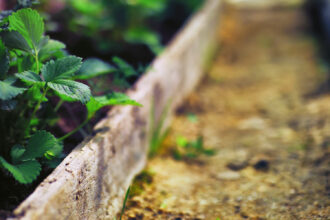In most cases, single-family houses have steep roofs, the rooflines of which extend beyond the outline of external walls. It is true that such a rafter can be left unprotected, but a much more aesthetic and practical solution is to finish a roofline from below. A soffit serves this purpose, also known as roof lining. It can be made of various materials.
Wooden soffit
A wooden soffit emphasizes the natural character of a building and looks noble. Wooden soffits are usually made of domestic wood species, such as:
- pine – with characteristic and well-defined knots and growth rings, impacted by sunlight, it darkens and becomes yellow-brown over time,
- spruce – if well impregnated, it should not darken for several years,
- larch – has a slightly reddish colour, and during aging it acquires a shade of grey.
Among the exotic types of wood, it is worth investing in those that are most resistant to pests and moisture:
- Siberian larch
- Scandinavian spruce with a very bright colour.
Wooden soffits create a tight layer, thanks to which, they increase the thermal insulation of an attic. In order for the wooden soffit to serve for years, it should be impregnated with varnish, wood stain or oil.
PVC soffit
A PVC soffit is resistant to weather conditions, requires no maintenance, is resistant to corrosion, mould and fungi. They are easy to keep clean. PVC soffits are relatively light and easy to install. There are two types of PVC panels available:
- siding type – they are made of thin and 3-4 m long elements, imitating several thin boards, they are easy to cut, they can be full or perforated,
- chambered double-layer panels – characterised by a great rigidity, the inner layer is made of foamed PVC, and the outer one is made of hard PVC, their length is 4-5 m.
Roof soffits made of PVC are durable, but in the event of scratches or mechanical damage, a plastic soffit cannot be repaired. Individual elements need to be replaced, which may involve disassembly of an entire structure. In addition, under the influence of very high temperatures, a PVC soffit can shrink and warp. Therefore, PVC panels should not be used on metal roofs that heat up quickly.
Metal soffit
A metal soffit can be made of sheet metal or durable steel, with steel panels being the most common. A metal soffit is durable and long-lasting, with no risk of deformation or warping due to high temperatures. They can imitate wood. A metal soffit should, however, be regularly maintained in order to protect it from rust.
Aluminium soffit
You can also opt for an aluminium soffit. It is characterised by high resistance to weather conditions and easy to install. It does not require maintenance, it is covered with a protective layer, usually made of polyester, less often in the form of a polyamide and anode-oxide layer. Aluminium panels can have a smooth or perforated surface.
Wood-based soffit
Another solution is a wood-based soffit, made of fresh wood shavings mixed with resin. A wood-based soffit is covered with acrylic paint, which protects it and gives it a specific colour. These types of soffits are resistant to adverse weather conditions, especially rainfall and high temperatures.


